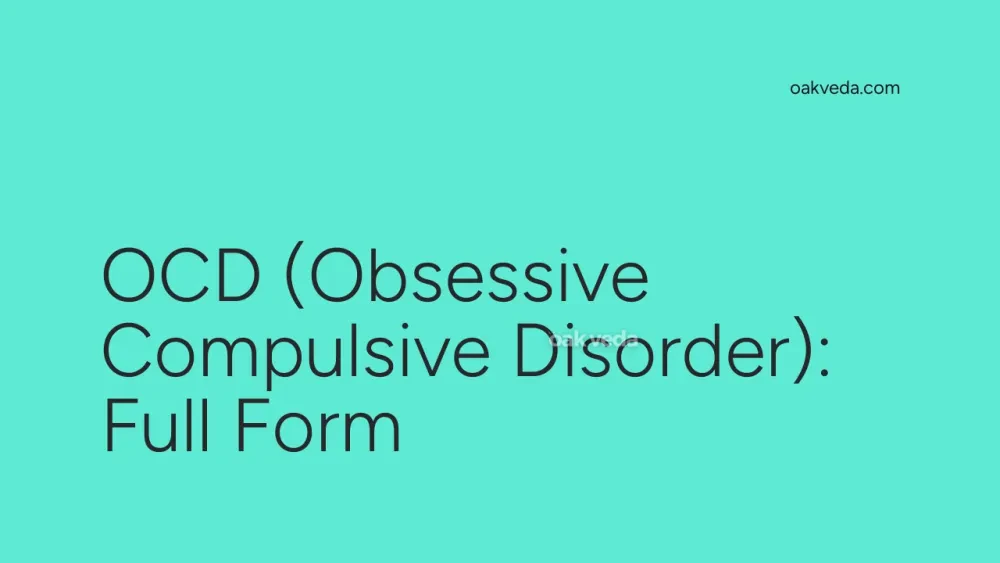
What is the Full Form of OCD?
The full form of OCD is Obsessive Compulsive Disorder. This mental health condition affects millions of people worldwide, causing significant distress and impairment in daily functioning. Understanding the full form of OCD is crucial for recognizing its symptoms and seeking appropriate treatment.
What is Obsessive Compulsive Disorder?
Obsessive Compulsive Disorder is a chronic mental health condition characterized by persistent, intrusive thoughts (obsessions) and repetitive behaviors or mental acts (compulsions). Individuals with OCD often feel compelled to perform these compulsions to alleviate anxiety or prevent perceived negative consequences.
Origin and Development of Obsessive Compulsive Disorder
The exact origins of OCD are not fully understood, but research suggests a combination of genetic, neurobiological, and environmental factors contribute to its development. Historical records show that OCD-like symptoms have been documented for centuries, with notable descriptions appearing in medical literature as early as the 17th century.
How does Obsessive Compulsive Disorder work?
OCD operates through a cycle of obsessions and compulsions:
- Obsessions: Unwanted, intrusive thoughts, images, or urges that cause anxiety or distress.
- Anxiety: The obsessions lead to increased anxiety and discomfort.
- Compulsions: Repetitive behaviors or mental acts performed to reduce anxiety or prevent feared outcomes.
- Temporary relief: Compulsions provide short-term relief, reinforcing the cycle.
This cycle repeats, often becoming more severe over time if left untreated.
Types of Obsessive Compulsive Disorder
While OCD manifests differently for each individual, some common types include:
- Contamination OCD
- Checking OCD
- Symmetry and ordering OCD
- Harm OCD
- Religious or moral OCD (Scrupulosity)
- Relationship OCD
- Pure O (primarily obsessional OCD)
Functions of Obsessive Compulsive Disorder
Although OCD is a distressing condition, it serves certain psychological functions:
- Anxiety reduction
- Perceived control over uncertain situations
- Attempt to prevent harm or negative outcomes
- Temporary relief from intrusive thoughts
Understanding these functions can help in developing effective treatment strategies.
Applications of OCD Research
Research into OCD has wide-ranging applications:
- Developing more effective treatments
- Understanding the neurobiological basis of anxiety disorders
- Improving diagnostic criteria for mental health conditions
- Advancing cognitive-behavioral therapy techniques
- Exploring potential genetic markers for early intervention
Features of Obsessive Compulsive Disorder
Key features of OCD include:
- Intrusive thoughts: Unwanted, distressing ideas or images
- Compulsive behaviors: Repetitive actions or mental rituals
- Time-consuming: OCD symptoms often take up significant time (1+ hours daily)
- Distress and impairment: Symptoms cause significant anxiety and interfere with daily life
- Insight: Varying levels of awareness about the irrationality of obsessions and compulsions
Benefits of Understanding OCD Full Form
Recognizing the full form of OCD offers several benefits:
- Improved awareness and destigmatization
- Earlier detection and intervention
- Better support for individuals with OCD and their families
- Enhanced research funding and public health initiatives
- Development of more targeted treatment approaches
Limitations or Challenges of OCD Management
Despite advancements in OCD treatment, several challenges remain:
- Treatment resistance in some cases
- Limited access to specialized OCD therapy in certain regions
- Comorbidity with other mental health conditions
- Stigma and misunderstanding surrounding OCD
- Long-term maintenance of symptom improvement
Future Developments in OCD Treatment
Exciting developments in OCD treatment are on the horizon:
- Personalized medicine approaches based on genetic profiles
- Advanced neuroimaging techniques for targeted interventions
- Virtual reality exposure therapy
- Innovative pharmacological treatments
- Integration of artificial intelligence in therapy delivery
FAQs on OCD Full Form
-
What is the difference between OCD and OCPD? OCD (Obsessive Compulsive Disorder) involves intrusive thoughts and compulsive behaviors, while OCPD (Obsessive Compulsive Personality Disorder) is characterized by rigid perfectionism and control.
-
Can OCD be cured completely? While there's no definitive cure, many individuals with OCD experience significant symptom reduction through proper treatment.
-
Is OCD hereditary? There is a genetic component to OCD, but environmental factors also play a role in its development.
-
At what age does OCD typically begin? OCD often begins in childhood, adolescence, or early adulthood, with the average age of onset being around 19 years old.
-
How is OCD diagnosed? OCD is diagnosed through a comprehensive evaluation by a mental health professional, using criteria from the DSM-5 (Diagnostic and Statistical Manual of Mental Disorders, 5th edition).
Understanding the full form of OCD – Obsessive Compulsive Disorder – is crucial for recognizing its impact and seeking appropriate help. With ongoing research and improved treatment options, individuals with OCD can find hope and support in managing their symptoms and improving their quality of life.
You may be interested in:
- PS (Postscript): Full Form and Usage Explained
- NCB (Narcotics Control Bureau): Full Form and Functions
- IRCTC (Indian Railways Catering and Tourism Corporation)
- NPCI (National Payments Corporation of India)
- GST (Goods and Services Tax): Full Form and Explained
- NTG (Nitroglycerin): Full Form and Medical Uses

